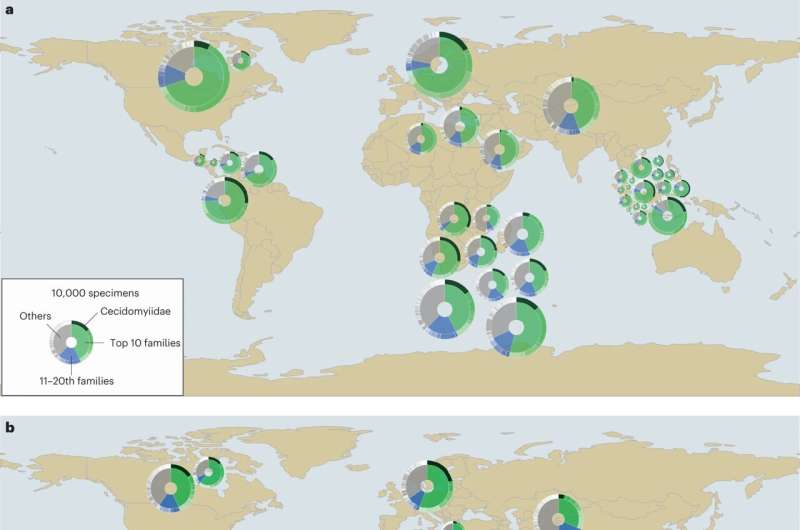This article has been reviewed according to Science X's editorial process and policies. Editors have highlighted the following attributes while ensuring the content's credibility:
fact-checked
peer-reviewed publication
proofread
Biodiversity discovery: Unknown species ('dark taxa') drive insect diversity

Biodiversity loss ranks among the top three risks to humanity, as stated in the 2023 World Economic Forum Global Risks Report. Understanding biodiversity's basic building blocks is essential to monitor changes, identify influencing factors, and implement appropriate policies. However, much of terrestrial animal diversity, including insects, remains unknown or "dark taxa."
For example, the global biodiversity information portal GBIF has nine times more information on birds than insects and arthropods, despite birds only accounting for 0.2% of biodiversity. Prof. Rudolf Meier, head of the Center for Integrative Biodiversity Discovery at the Museum für Naturkunde Berlin, highlights the importance of this study in addressing this deficit for effective nature conservation. He emphasizes the need to learn more about insects, as their combined biomass and biodiversity far surpass that of all vertebrates, and they are crucial for survival.
To determine the global taxonomic composition of flying insects, researchers used Malaise traps. These standardized traps are widely employed in global biomonitoring programs. However, analyzing samples is challenging when examining individual insects. Thanks to recent advances in sequencing technologies, biodiversity can now be estimated with "DNA barcodes."
Researchers used DNA barcodes to assign 225,261 specimens to 25,000 species to 458 families. Dr. Amrita Srivathsan, the study's lead author, noted the surprising finding that 10–20 families dominate flying insect communities worldwide. This is remarkable as samples were collected from various climates and habitats like tropical rainforests, montane forests, cedar savannas, scrub forests, thorn fields, mangroves, and swamps, with only Australia and Antarctica not being sampled.
Describing insects is a major challenge in understanding life on Earth, with over 80% still undescribed. The authors emphasize that a large fraction of terrestrial animal biodiversity remains unknown to science and will continue to be, unless "dark taxa" become a priority target in biodiversity research.
The work is published in the journal Nature Ecology & Evolution.
More information: Rudolf Meier, Convergence of dominance and neglect in flying insect diversity, Nature Ecology & Evolution (2023). DOI: 10.1038/s41559-023-02066-0. www.nature.com/articles/s41559-023-02066-0
Journal information: Nature Ecology & Evolution
Provided by Leibniz Institut für Evolutions-und Biodiversitätsforschung





















